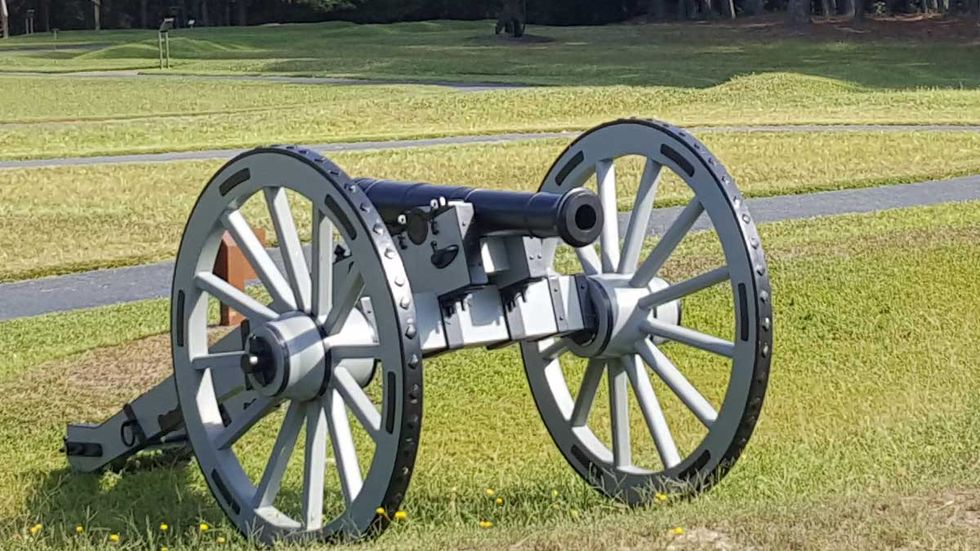
© 2025 Blaze Media LLC. All rights reserved.
If you, like me, grew up in the North, you probably weren’t taught a whole lot about the South in the Revolutionary War. Looking back in textbooks, the history taught was heavily centered on the current Northeastern states’ contributions to the independence effort. From Lexington and Concord to Valley Forge — that is where the focus always was. If the South was mentioned at all, it was mainly either Yorktown or the “Swamp Fox.” When I moved to Greenville, SC – named for Revolutionary War general Nathaniel Greene – I wanted to find out more about the South’s contributions.
I am a firm believer that in order to learn about this great country we call home, you need to visit it. I’ve shared my trips through coal and oil country and to the heartland with readers before. So I got in my car and took a look around. Next time you take that trip to Myrtle Beach, you too can get in the car and look around at some of these places I’ve visited in South and North Carolina that had a major effect on the war effort.
There are four particular Revolutionary War attractions that are well worth your time to visit. All are operated by the National Park Service. The first, which encompasses the second and third, is the Overmountain Victory Trail.
The Overmountain Victory Trail
The Overmountain Valley Victory Trail is a motor route over 300 miles long that travels through the states of Virginia, Tennessee, North Carolina, and South Carolina. It strings together sites from the Southern campaign of the war. And in addition to the history, it traverses some of the most breathtaking terrain in the Eastern states.
The South had been relatively untouched by the Revolution until 1779, when the British decided to focus on the area to split the American Colonial forces. To meet that newfound threat, about 1500 Colonials traveled down over the Blue Ridge Mountains toward South Carolina, where the bulk of the British and Tory operations were taking place.
The trail follows, as closely as possible, that march. It has numerous stops along the way where you can learn more about the history of this important part of the war, which culminated in the surrender of Cornwallis at Yorktown a few years later. The next time you are driving South on vacation, or if you live in the area, take some time to drive the route. It is well worth it.
Cowpens
The war in the North was marked by guerrilla tactics like those employed as the British marched back to Boston from Lexington and Concord. The Battle of Cowpens was one of the first victories for the Colonials in open-field combat. According to the National Park Service, the victory was one of only a few in military history to successfully employ a “double envelopment” against the losing side.
Cowpens is considered to be the turning point in the war in the South. After two years of British and Loyalist militia victories throughout South Carolina, Cowpens was the first major loss for the British in the theater, “turning the tide” of the war and setting in motion the events that led to the surrender of Cornwallis later in 1781.
The historical site is located on SC Route 11, also known as the Cherokee Parkway. It is just north of the infamous Gaffney Peach. When visiting, you will get a deeper appreciation for how the Revolutionary War was actually a civil war, pitting neighbor against neighbor, as there were stronger Loyalist tendencies in the South than in the North. It is an easy and informative two-hour diversion from I-85 on the way from Charlotte to Atlanta.
Kings Mountain
Close to Cowpens, and viewable from I-85, is Kings Mountain National Battlefield. Just south of the North Carolina border, the Kings Mountain battle is unique. It was truly a civil war battle. As the National Park Service describes:
Kings Mountain is a unique battle for several reasons. It was one of the few major battles of the war fought entirely between Americans: no British troops served here. In the South, many people were divided. When the war started, some fought for independence, others for loyalty to England.Kings Mountain is also unique in that large numbers of riflemen fought here. Rifles were not used much by the armies. A rifle was a hunting weapon, used by families on the frontier. The American militia that fought here mainly used rifles; the Loyalist troops had mostly muskets.
The victory came after a staggering chain of Colonial losses to Cornwallis. It reinvigorated the Patriot cause and will to fight. In that way, it gave the Colonial forces the courage to fight at Cowpens months later.
The battlefield itself is situated on a mountain, and the National Park site is surrounded by a South Carolina State Park that offers numerous recreational activities. It’s a great place to mix some light hiking with historical learning.
Ninety Six
Like the other sites in South Carolina, Ninety Six tells the story of the “civil war” nature of the Revolutionary War. It was so named because it was almost halfway between Charleston and the Cherokee village of Keowee, about 96 miles from each. The British realized the strategic importance of the town, and it became a fortified Loyalist stronghold.
Here’s how the National Park Service describes its importance:
Ninety Six proved to be a strategic location in the Revolutionary War. The first land battle south of New England was fought here in 1775. Later in the war, Ninety Six figured prominently in the Southern Campaign of the American Revolution. In 1780, the British fortified the strategically important frontier town. From May 22 - June 18, 1781 Major General Nathanael Greene with 1,000 patriot troops staged the longest field siege of the Revolutionary War against 550 loyalists who were defending Ninety Six. The earthen Star Fort remains as one of the best preserved examples of an original 18th century fortification.
Ninety Six is a little harder to get to than the other sites previously discussed. It is in the middle of SC, west of Columbia and off the beaten track. It is the most interesting of the sites, in that you get a feel for town life on what was then really the frontier. You also get a real sense of what a late 18th-century frontier fort was like and how the siege unfolded.
If you are as interested in history as I am, why not make a trip to the Carolinas your next history road trip? You won’t be disappointed.
How do we stop the mainstream media from warping the national narrative? We push back together. With the truth. Be the first to receive CRTV’s free weapon against the worst the media has to offer. Introducing WTF MSM!?
Want to leave a tip?
We answer to you. Help keep our content free of advertisers and big tech censorship by leaving a tip today.
Want to join the conversation?
Already a subscriber?
Rob Eno is the managing editor of Blaze News. He is from Massachusetts and now resides in the freedom of Texas.
Rob Eno
Rob Eno is the managing editor of Blaze News. He is from Massachusetts and now resides in the freedom of Texas.
more stories
Sign up for the Blaze newsletter
By signing up, you agree to our Privacy Policy and Terms of Use, and agree to receive content that may sometimes include advertisements. You may opt out at any time.
Related Content
© 2025 Blaze Media LLC. All rights reserved.
Get the stories that matter most delivered directly to your inbox.
By signing up, you agree to our Privacy Policy and Terms of Use, and agree to receive content that may sometimes include advertisements. You may opt out at any time.






